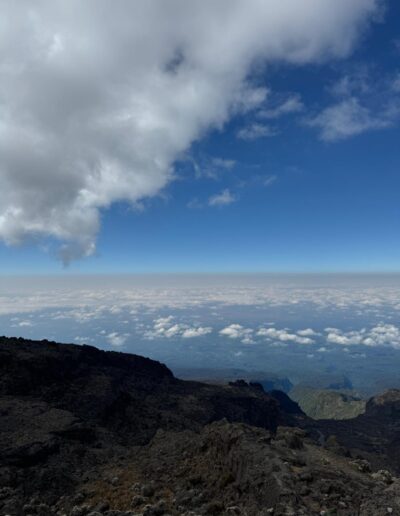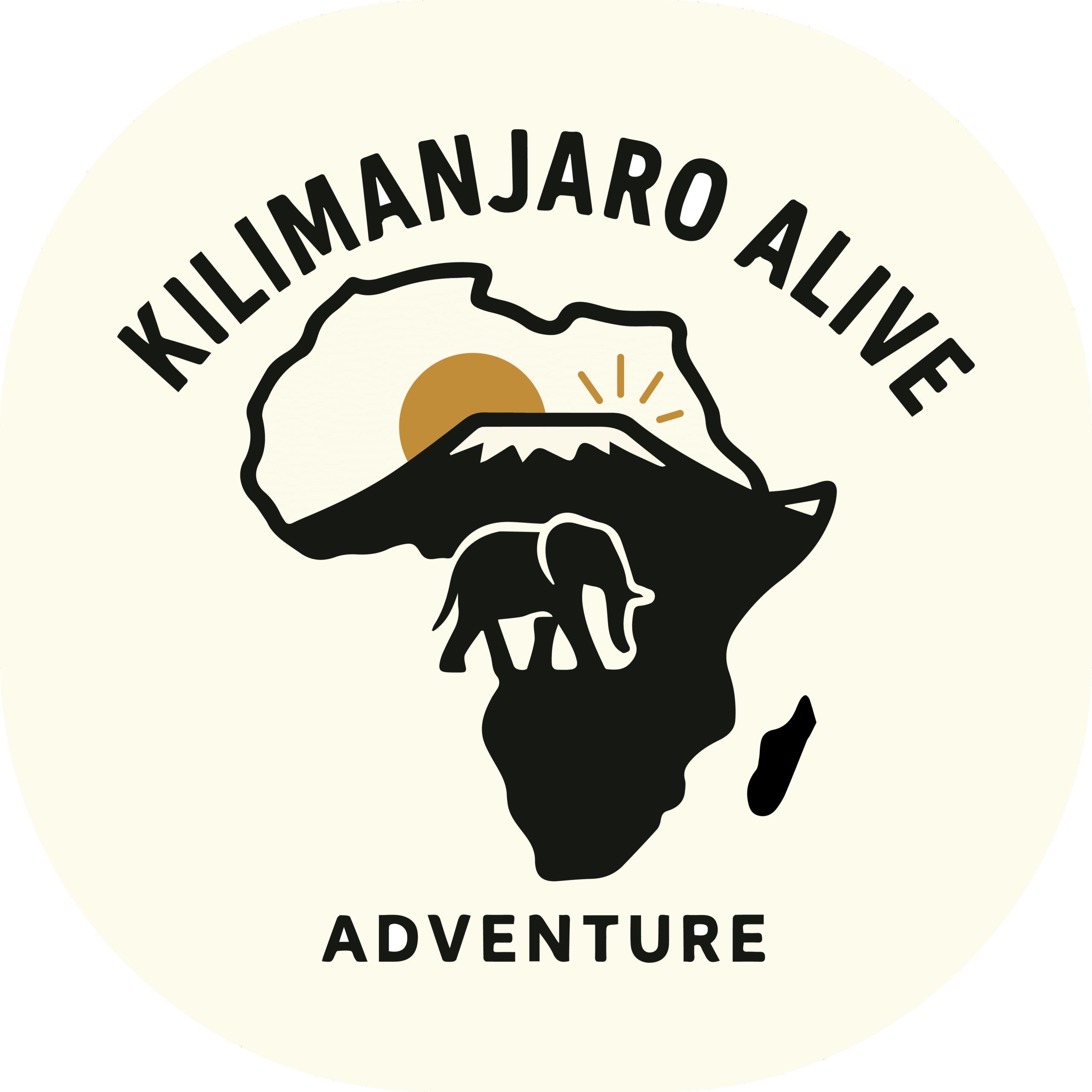NOTHERN CIRCUIT (9 DAYS)
The Ultimate Kilimanjaro Experience
The Northern Circuit Route is the longest and most scenic path to the summit of Mount Kilimanjaro. It circles the mountain’s quieter northern slopes, offering unmatched acclimatization, remote wilderness, and breathtaking landscapes. With fewer crowds and a high success rate, it’s ideal for climbers who want a deeper connection to the mountain, more time to adjust, and the best chance of standing on Uhuru Peak – 5,895 meters above sea level.
Description
Day 0 | Arrival in Tanzania
Welcome to Tanzania! Upon your arrival at Kilimanjaro International Airport, you will be greeted by a representative from Kilimanjaro Alive adventure who will transfer you to your hotel in Moshi. After check-in, you can relax, explore the town, and prepare for your exciting journey ahead. In the evening, you will attend a pre-climb briefing with your guide who will provide you with important information about the climb.
Day 1 | Lemosho Gate to Mti Mkubwa Camp
Altitude: 2,100m to 2,650m
Hiking Time: 3–4 hours | Distance: ~7 km
Zone: Rainforest
After registration at Lemosho Gate, you begin your adventure with a gentle hike through lush rainforest. Look out for black-and-white colobus monkeys. Tonight, you’ll camp at Mti Mkubwa(Big Tree Camp).
Day 3 | Mti Mkubwa to Shira 1 Camp
Altitude: 2,650m to 3,610m
Hiking Time: 5–6 hours | Distance: ~8 km
Zone: Heath & Moorland
The trail climbs steeply before entering the heather zone. You cross into the Shira Plateau, an ancient lava field offering expansive views. Camp tonight at Shira 1 Camp, where Kilimanjaro’s glaciers begin to feel within reach.
Day 4 | Shira 1 to Shira 2 Camp
Altitude: 3,610m to 3,850m
Hiking Time: 4–5 hours | Distance: ~7 km
This is a shorter, easier day for acclimatization. Traverse the high-altitude plateau and enjoy distant views of Mount Meru and the Western Breach. Shira 2 Camp is your home for the night.
Day 4 | Shira 2 to Moir Hut
Altitude: 3,850m to 4,200m
Hiking Time: 5–7 hours | Distance: ~10 km
You now leave the main trail and head north into quieter alpine terrain. After a scenic walk, reach Moir Hut, tucked below the Lent Hills. It’s a perfect spot for an optional acclimatization hike.
Day 5 | Moir Hut to Buffalo Camp
Altitude: 4,200m to 4,020m
Hiking Time: 5–7 hours | Distance: ~12 km
Climb out of Moir Valley and continue on the remote Northern Circuit trail. From the top of the ridge, the views toward Kenya are stunning. Descend to Buffalo Camp, nestled in a high alpine landscape few ever see.
Day 6 | Buffalo Camp to Third Cave Camp
Altitude: 4,020m to 3,870m
Hiking Time: 5–6 hours | Distance: ~8 km
Continue across the northern slopes through untouched wilderness. The trail undulates through dry alpine desert as you approach Third Cave Camp, where you rest before heading to summit base.
Day 7 | Third Cave to School Hut (Base Camp)
Altitude: 3,870m to 4,750m
Hiking Time: 4–5 hours | Distance: ~5 km
A gradual ascent brings you to School Hut, your final stop before summit day. You’ll prepare your gear, eat an early dinner, and rest before your midnight departure.
Day 8 | Summit Day – Uhuru Peak and Descend to Mweka Camp
Altitude: 4,750m to 5,895m (Uhuru Peak), then down to 3,100m
Hiking Time: 12–14 hours | Distance: ~17 km
This is your toughest but most rewarding day. You begin your final ascent at night, reaching Gilman’s Point at dawn, then continuing to Uhuru Peak, the Roof of Africa. After a short celebration, descend via Barafu Route to Mweka Camp for your last night on the mountain.
Day 9 | Mweka Camp to Mweka Gate – Return to Arusha
Altitude: 3,100m to 1,640m
Hiking Time: 3–4 hours | Distance: ~10 km
The descent through the rainforest is peaceful and reflective. At Mweka Gate, you receive your summit certificate and meet your driver. Return to Mount Meru Game Lodge for a hot shower and well-earned rest.
This package includes the following :
This package does not include the following :






Frequently Asked Questions: Climbing Mount Kilimanjaro
Before You Go: Preparation & Conditions
How hard is it to climb Mount Kilimanjaro?
Climbing Mount Kilimanjaro is challenging but achievable with the right preparation. It is a non-technical climb, meaning no special equipment is needed, but the altitude and physical endurance required can make it tough. With proper acclimatization, physical fitness, and support from experienced guides, most people in good health can reach the summit.
What is the best time of year to climb Kilimanjaro?
The best times to climb Mount Kilimanjaro are during the dry seasons: from January to mid-March and from June to October. These months offer more stable weather, clearer skies, and better trail conditions, making the ascent more enjoyable.
How do I train for a Kilimanjaro climb?
Training for Kilimanjaro should include cardiovascular exercises like running, cycling, or swimming, along with strength training for your legs and core. Regular hikes with a loaded backpack will help simulate the conditions of the climb. It’s also important to work on endurance, as the ascent involves long days of hiking at high altitudes. Explore more about our Kilimanjaro planning guide here
How fit do I need to be to climb Mount Kilimanjaro?
While you don’t need to be a professional athlete, a good level of physical fitness is essential. You should be comfortable with long days of hiking, as the ascent can take several hours each day. Endurance training, cardiovascular exercise, and regular hiking practice are recommended in the months leading up to your climb.
Planning & Logistics
How long does it take to climb Kilimanjaro?
The duration of a Kilimanjaro climb varies depending on the route. Most climbs take between 5 to 9 days. Longer routes like the Lemosho or Northern Circuit allow more time for acclimatization and increase the chances of reaching the summit successfully.
How much does it cost to climb Kilimanjaro?
The cost of climbing Kilimanjaro varies based on the route, duration, and services included. On average, a well-organized climb can range from $1,800 to $4,000. This includes park fees, guides, porters, food, and accommodations. Resilience Expeditions offers competitive prices with personalized service to ensure a memorable and safe experience. Click here to learn more about Kilimanjaro cost
Which is the best route to climb Kilimanjaro?
There are several routes to climb Kilimanjaro, each offering unique experiences. The Machame Route is popular for its scenic beauty, while the Lemosho and Northern Circuit routes provide more gradual acclimatization. The Marangu Route is the only one with hut accommodations. Your choice should be based on your experience, fitness level, and preferences for scenery and crowd levels.
What is included in the Kilimanjaro climb package?
Our Kilimanjaro climb packages typically include park fees, professional guides, porters, camping equipment, meals, and transportation to and from the mountain. Some packages may also include accommodations before and after the climb. We ensure you have everything you need for a successful and comfortable adventure. Click here to learn more about our packages.
Gear & Packing
Do I need any special equipment to climb Kilimanjaro?
No technical climbing equipment like ropes or harnesses is required to climb Kilimanjaro. However, you’ll need proper hiking gear, including warm clothing, a good sleeping bag, hiking boots, and a daypack. Our team provides a detailed packing list to ensure you’re fully prepared.
Do I need a visa to climb Kilimanjaro?
Yes, most visitors to Tanzania will need a visa to enter the country. You can obtain a visa on arrival at Kilimanjaro International Airport or apply online in advance. Make sure your passport is valid for at least six months beyond your entry date.
What should I pack for climbing Kilimanjaro?
For a Kilimanjaro climb, you’ll need layers of warm clothing, including thermal underwear, a fleece jacket, a down jacket, waterproof pants, and gloves. Good-quality hiking boots, a headlamp, sunglasses, and a hydration system are also essential. We provide a full packing list to help you prepare. Click here to explore our packing list
Do I need travel insurance to climb Kilimanjaro?
Yes, travel insurance is highly recommended for your Kilimanjaro climb. It should cover high-altitude trekking, medical emergencies, trip cancellations, and evacuation services. Be sure to check with your provider to ensure you’re fully covered.
Health, Safety & Support
Is it safe to climb Kilimanjaro?
Yes, climbing Kilimanjaro is generally safe when done with an experienced guide team like Resilience Expeditions. Our guides are trained in first aid and altitude sickness management. We follow strict safety protocols and carry medical supplies, including oxygen, on all climbs. We also encourage clients to climb slowly, allowing their bodies’ time to adjust to the altitude.
What happens if I can’t reach the summit?
Not everyone reaches the summit of Kilimanjaro, and that’s okay. Our primary goal is your safety. If you feel unwell or our guides determine that it’s unsafe for you to continue, we will assist you in descending. Even reaching high-altitude camps is a significant achievement.
What is altitude sickness, and how can I prevent it?
Altitude sickness occurs when your body doesn’t adjust well to the reduced oxygen levels at high altitudes. Symptoms include headaches, nausea, and shortness of breath. To reduce the risk, we recommend choosing a longer route for better acclimatization, staying hydrated, and following the “climb high, sleep low” principle. Our guides are trained to recognize signs of altitude sickness and will monitor your health closely. Learn more about mountain sickness here
What kind of food is provided during the climb?
Our Kilimanjaro climbs include nutritious and energy-boosting meals to keep you fueled throughout the ascent. Typical meals include soups, pasta, rice, vegetables, and fruits. We can accommodate dietary restrictions, so please inform us in advance of any specific needs.
On the Mountain: Trekking Experience
What is summit night like on Kilimanjaro?
Summit night is the most challenging part of the climb. You’ll begin the ascent around midnight to reach the summit at sunrise. The climb is steep, cold, and long, but reaching Uhuru Peak as the sun rises is a rewarding and unforgettable experience. Our guides will motivate and support you every step of the way.
Can I climb Kilimanjaro solo?
While it is possible to climb Kilimanjaro solo, Tanzanian regulations require you to be accompanied by licensed guides. Climbing with a reputable tour operator like Resilience Expeditions ensures your safety, increases your chances of summiting, and provides a more enjoyable experience.
How many people will be in my Kilimanjaro group?
Group sizes vary, but we prefer smaller groups to provide personalized attention and enhance safety. On average, groups consist of 5 to 10 climbers, along with guides, porters, and cooks. If you prefer a private climb, we can also arrange that.
Will I have internet or cell phone service during the climb?
Cell phone service is available at lower elevations but becomes less reliable as you ascend. Some camps offer limited mobile network coverage. However, part of the adventure Is disconnecting from technology and fully immersing yourself in the experience of the climb.
